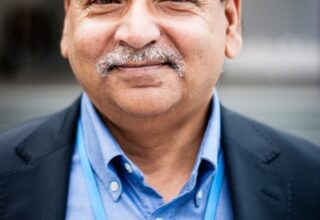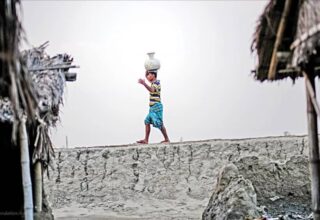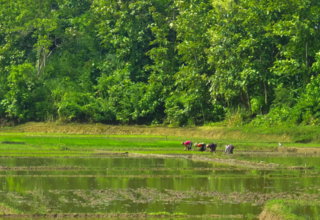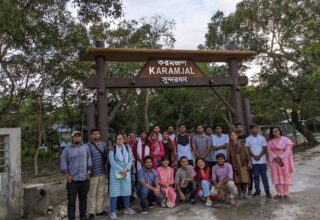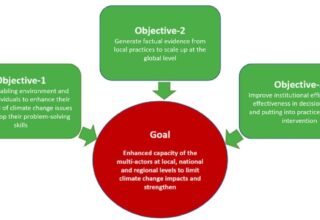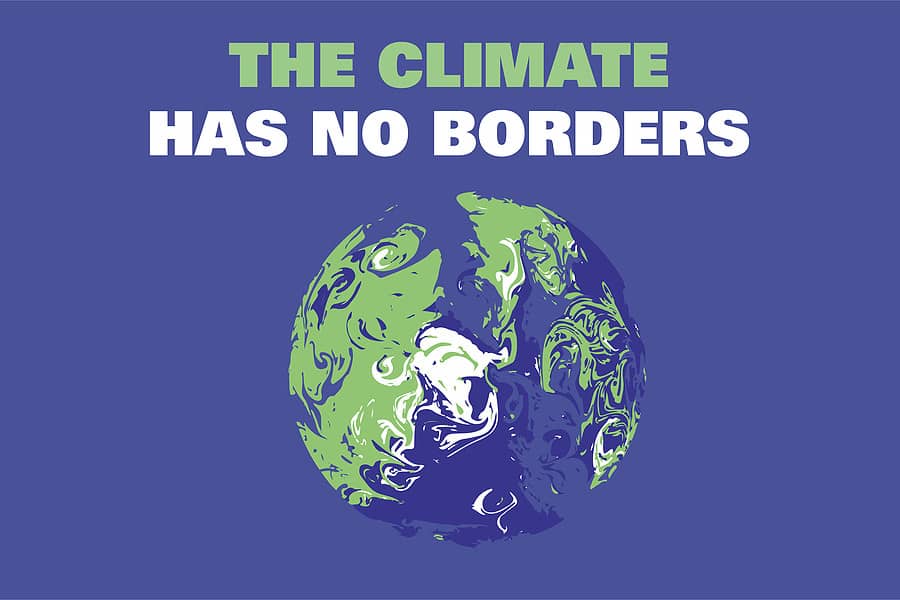
The Intergovernmental Panel on Climate Change (IPCC), the world’s premier body for climate science, released two crucial reports in early 2022 under its 6th Assessment Report that confirm what we already know: The climate crisis is an issue of the present and its impacts are already being felt across the world, with the hardest-hitting impacts disproportionately affecting the more than 3 billion people living in vulnerable developing countries and communities. The report provided a grim prediction for the future estimating that in the next decade alone, climate change will drive between 32 – 132 million more people into extreme poverty.
While it has been heartening to see the elevation of climate adaptation over the past few years, such efforts will not be enough even if the world were to achieve the Paris Agreement goal of limiting global average temperature increases to 1.5 degrees Celsius, regardless of the fact that funding for adaptation action is far from sufficient, representing a measly 25% of total international climate finance. Even with the commitment to double adaptation finance to $40 billion by 2025, that amount is a pittance compared to what is needed and will lead to an adaptation deficit and higher losses and damages.
Evidenced by the fires in the United States and Greece, the flooding in Germany and Sudan, the life-threatening heat waves in India and across Sub-Saharan Africa, the rising sea-levels threatening the existence of island nations in the Pacific and Caribbean, and so on, climate impacts are already happening and necessitate action to address the losses and damages that result.
Bangladesh suffered 185 extreme events due to climate change between 2000-2019 resulting in economic losses to the tune of $3.72 billion. Typhoon Haiyan, which struck the Philippines in 2013, caused devastation resulting in $864m in damages. During the 2009-2011 drought in Kenya, GDP decreased by 2.8% per year. According to UNDRR, losses from natural hazards in 2020 alone were on the order of US$210bn, which was over 25% higher than in the previous year.
In contrast the international funding for disaster risk reduction compared poorly against the economic losses experienced by countries. A 2018 study estimated that total damages in developing countries could reach $290-580bn by 2030 and $1.1-1.7 trillion by 2050.
Action to address loss and damage is urgent and represents an issue of solidarity and justice as vulnerable communities suffer the greatest losses and damages with the lowest access to resources to address them.
While COP26 in Glasgow saw some critical breakthroughs with unprecedented unity Group of 77 and China — on the need for a loss and damage finance facility to support action on loss and damage, the outcomes from the conference were insufficient. Instead, countries agreed to set up the Glasgow Dialogue on Loss & Damage Finance, but more efforts are needed to make sure that this results in a tangible outcome and does not lead to another talk-shop with nothing to show for it.
To ensure success in mobilizing loss & damage finance at COP27 in Egypt, three key pillars must be pursued:
(1) Maintaining unity in the Global South
(2) Building a bridge of solidarity from the Global North on this issue
(3) Providing robust scoping for a loss & damage finance facility.
Pillar 1: Maintaining unity in the Global South
At COP26, there was unprecedented unity among countries from the Global South as the Group of 77 and China came together in one voice to demand the establishment of a loss & damage finance facility. Driven by the clear and present dangers presented by the climate crisis, the countries of the Global South were able to elevate loss & damage, a topic historically side-lined especially by developed countries, to be front and centre in the negotiations.
While efforts to establish a loss & damage finance facility at COP26 were ultimately thwarted by developed countries, the significant rise in prominence of conversation around loss & damage since COP26 demonstrates the power of developing countries to collectively lobby as long as they remain in that collective.
The Glasgow Dialogue on Loss & Damage Finance presents a hook that the Global South must capitalize upon. Looking to the UN climate meetings in Bonn, Germany in June and COP27 in Egypt in November and throughout the Glasgow Dialogue, efforts need to continue to maintain this unity among Global South countries by supporting coordination between countries and country blocs and by supporting the development of concrete messaging for developing country negotiators with clear asks.
Doing so will help to keep the breakthrough unity witnessed at COP26 to drive more ambitious outcomes from the Glasgow Dialogue and ensure that it produces tangible results in mobilizing finance for vulnerable countries and communities to address climate change-induced losses & damages.
Pillar 2: Building a bridge of solidarity from the Global North on this issue
With the IPCC 6th Assessment Reports, the science of the impacts of climate change and its disproportionate impacts on developing countries are indisputable. As drivers of the climate crisis and as a sign of solidarity, the Global North needs to recognize the issue of loss & damage and engage the Global South proactively and in good faith to find a solution for mobilizing the necessary funds to address loss & damage.
To demonstrate good faith efforts, such engagement needs to be anchored in the needs of developing countries and safeguard the agency of vulnerable countries and communities to respond when disaster strikes as a result of the climate crisis. Engagement efforts can and should target coalitions like the Vulnerable 20 Group (V20), a group of finance ministers from countries that are part of the Climate Vulnerable Forum, to make sure the needs of vulnerable countries are at the core.
Scotland served as a pioneer by committing £2 million to loss and damage finance at COP26 (similar commitments were made by the government of Wallonia and a group of philanthropies) and should inspire similar action from other developed countries. The IMF has established the Resilience and Sustainability Trust fund (RST) and the extent to which it will support the climate risk and loss and damage agenda remains to be seen.
The eyes of the world will be particularly focused on the G7, especially the United States, the United Kingdom, and the European Union, for signals on progress. On its website, the German Presidency of the G7 expressed its desire to “create a global shield against climate risks.” While this is a welcome sign, how this is achieved — both in terms of the process to design this shield as well as what the final initiative looks like — will be critical benchmarks.
In the lead up to COP27 and beyond, efforts must be made to jettison historical stand-offs by making the case using the robust evidence base and to elevate the clear asks from the Global South, pushing the Global North to demonstrate solidarity with the Global South on loss & damage finance.
Pillar 3: Robust scoping of the facility
Such efforts to foster unity in the Global South and push for solidarity from the Global North will need to be informed by a robust, evidence-based approach. Loss & damage finance is tricky because losses & damages can occur in a wide range of contexts — from disasters triggered by extreme events to slow-onset events or from economic to non-economic losses and damages, just to name a few examples.
Further, the actions and investments range from preemptive ones to avert and minimize loss and damage which interfaces with the adaptation agenda as also the crying need to keep temperature increase in check, to those that need to be addressed due to breach of the hard and soft limits to adaptation.
The latter also includes an interface with the emergency responses from the humanitarian sector. To develop the campaign to push the Global North and to ensure that the Global South has the tools and knowledge necessary to advocate for a fit-for-purpose facility, efforts to build out the evidence base will need to continue, drawing from the ongoing work from initiatives such as the Warsaw International Mechanism on Loss & Damage, humanitarian networks, and other civil society organizations. Such research will help to establish why a separate facility is needed and inform what that facility should look like to ensure that any finance provided will be accessible and fit-for-purpose.
However, doing such research will not be enough. This needs to be accompanied by efforts to socialize the research to key decision makers across the world while providing the necessary knowledge and financing technical assistance through the Santiago Network on Loss & Damage. Furthermore, such scoping efforts can be used to hold the countries of the Global North accountable to commitments for loss & damage finance so that such commitments aren’t delayed or left unfulfilled, like the $100bn/year commitment made at COP15 in 2009 that has yet to be met.
Enshrined in the UN Framework Convention on Climate Change are the values of equity and fairness. In an international climate action regime that seeks to address climate justice, loss & damage finance is a necessary tool and key to rebuilding trust and solidarity in the multilateral system. The best available science shows that even in a 1.5-degree world, we will not be able to buy our way out of the real climate impacts solely with adaptation efforts — addressing losses & damages will be essential and must be pursued on equal footing with mitigation and adaptation efforts.
Through the three pillars discussed above, COP27 can and should result in agreement on establishing a mechanism that the remaining years of the Glasgow Dialogue will then complete. COP27 is slated to be the “Implementation COP,” the “COP of the Vulnerables,” the “Africa COP.” If that is to hold true, the current UK Presidency of the COP will need to meaningfully collaborate with the incoming Egyptian Presidency to ensure that the Glasgow dialogue is not “blah blah blah,” but rather results in tangible, transformative outcomes that support the resilience and safety of communities around the world.
Originally this article was published on May 18, 2022 at Dhaka Tribune.
Preety M Bhandari is Senior Advisor, Climate Change and Finance at the World Resources Institute; Nataniel Warszawski is Research Associate, International Climate Action in the Global Climate Program at WRI and co-coordinator of the ACT 2025 initiative. This Op-Ed was prepared by World Resources Institute under its affiliation with Alled for Climate Transformation 2025 (ACT 2025)


